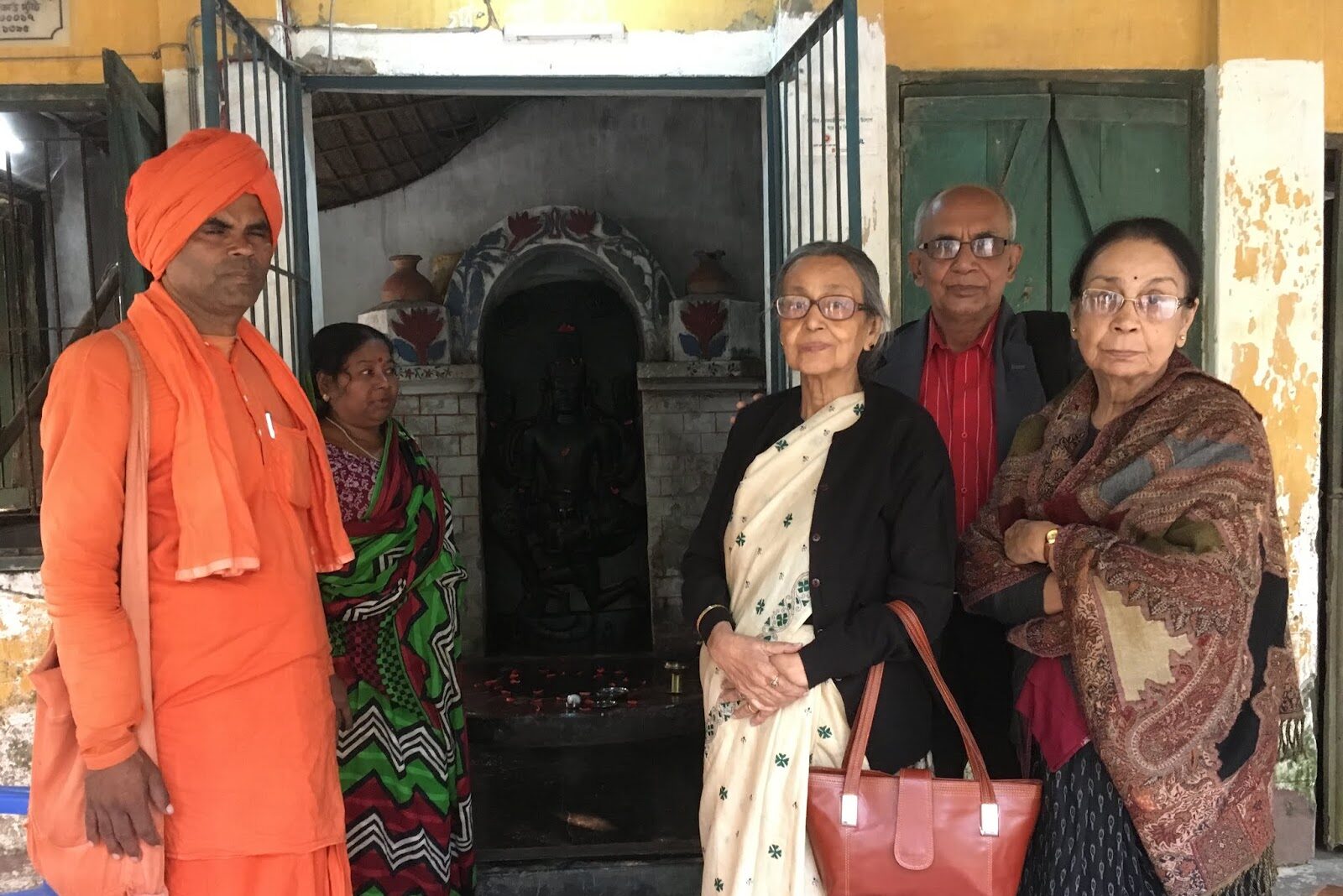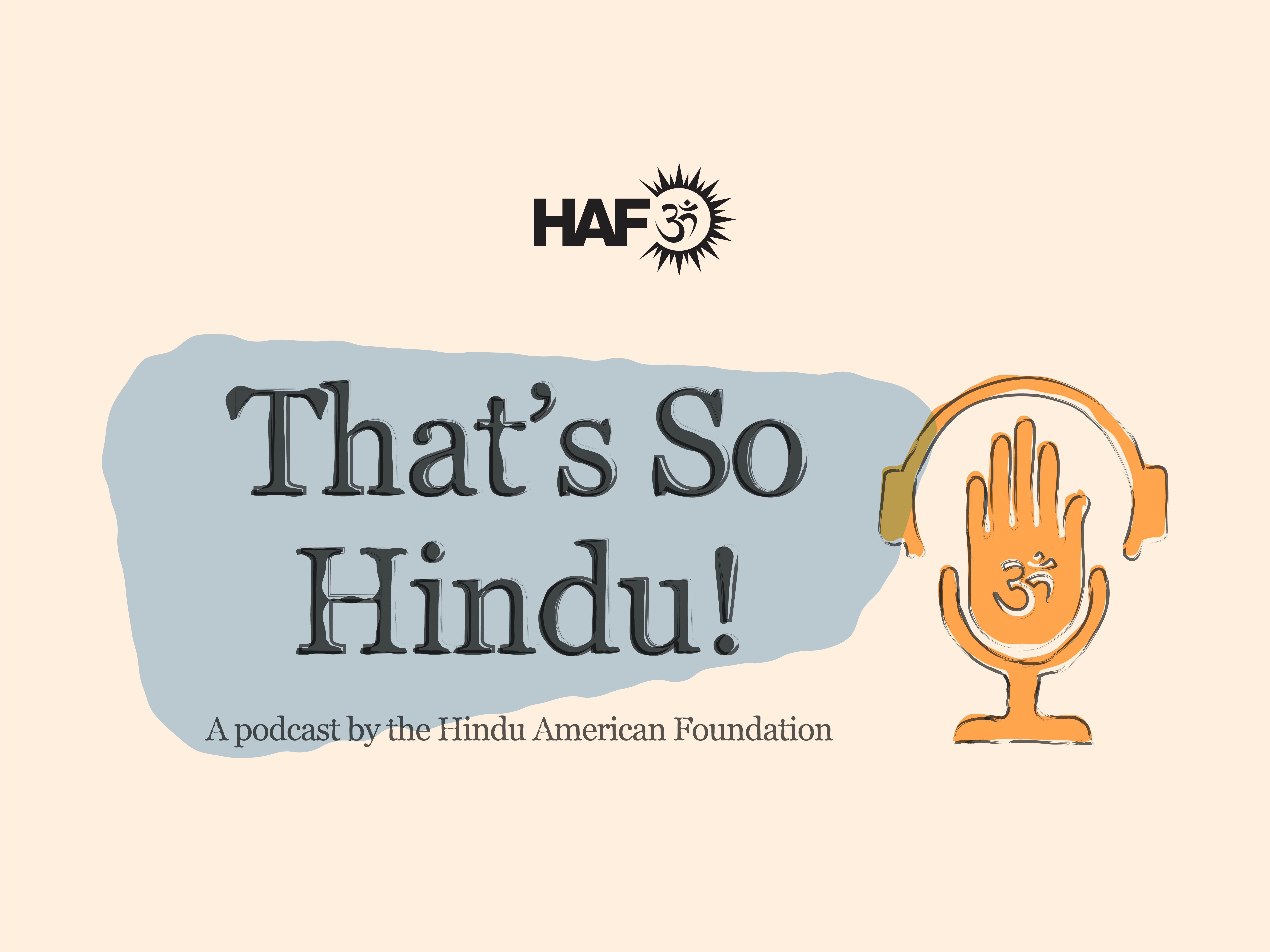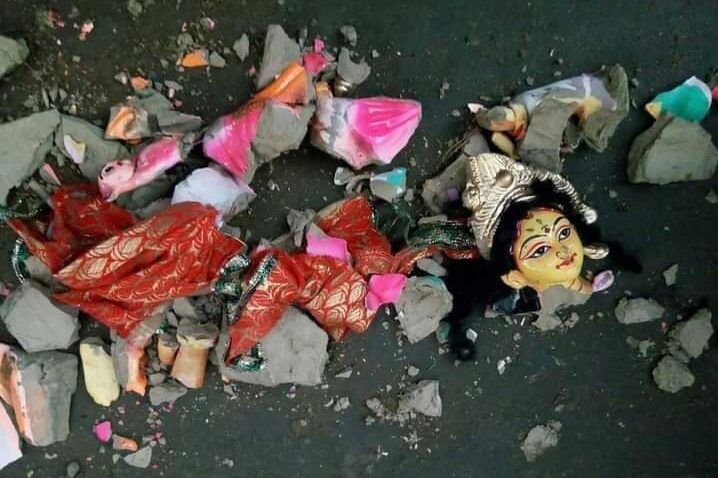

Dr. Sachi Dastidar (second from right) and others stands outside a 15th-century Vishnu temple in the Barisal District of Bangladesh. Its original structure damaged during the pogroms of the 1950s, the deity now sits in a poorly constructed shed with leaky windows and doors.
What was life like before Partition?
My family was very highly educated. In 1919, my mother stood first in all of East Bengal in her school exam. That same school exists now in her name, because she was probably the first girl to stand first in that college school exam.
My maternal grandfather was a lawyer and involved in politics and India’s independence movement. My grandmother, grandfather, and two uncles spent over 17 years in prison — British criminal prison as I call it — because it was a colonizer’s prison for those who participated in India’s independence movement. One of my uncles passed his I.A., B.A., and M.A. from behind bars. He became, I think at one time, head of the Journalist Association of India in Delhi.
So they were very highly educated and they were very active in social politics. Because of this, once Partition happened, there was an attack on my maternal grandfather. He managed to rent a boat and take them to the Indian border, after which they lived in a little hut. Once the division took place, you became no one.
How would you describe the period directly leading up to the Partition?
Directly leading up to Partition, there were two parallel things, particularly in Bengal. You have one group, the Congress Party, wanting India’s independence as a united India. And then you have the Muslim League, which was ruling the Province of Bengal, wanting the Partition of India, and all of Bengal to become part of the Islamic republic.
This, however, was prevented by Shyama Prasad Mukherjee, who wanted to have a referendum. When Bengal did the referendum, some parts that were Hindu majority, like parts of my family’s district, remained in East Pakistan. Chittagong Hill for example, was 99% non-Muslim, but for some reason the district was given to Pakistan.
So life was very tough as Partition took place because you had to find a shelter. Being homeless is not easy. Even as educated middle-class people, my parents, you’d be surprised to know, didn’t have money, not even four rupees, which is maybe 25-50 cents, to send me to school during the first four years. And because in Indian culture you are never alone, my father, who was the oldest in the family, had to take care of uncles, aunts, cousins, etc. So that was the real tussle in terms of survival.
What feelings and images come to mind when remembering Partition itself?
Partition is a really, really bad memory — the slaughter of Hindu minorities and the taking of their homes without paying a penny.
Pakistan created a law, which is still in Pakistan and Bangladesh called the Enemy Property Act. Under this act, indigenous Hindu minorities who were there before any Muslim, can be declared an enemy of the state, and a stranger can walk in and take their home without having to pay a penny. There is nothing in the world more miserable than that. The Hindus are the ones who established the village. The Hindus are the ones who invited the Muslims, yet the Hindus are the ones who were driven out.
You become homeless and you can bring almost nothing. So it’s a horrendous thing. And there’s also forced conversion, the destruction of temples, and the destruction of deities. I just spoke to a person in Bangladesh who’s trying to recover an old deity found in a pond in one of the villages of the Barisal District. That was a very common thing, when people came to destroy the temples, devotees hid the deities in the pond, hoping they could find them later. As such, there are a huge number of deities that have been found in ponds.
So, yes, Partition reminds me of very horrendous things: forced conversion and the slaughter of individuals for no reason — only because they were part of the Hindu minority.
In August 1947, after some 300 years, the British finally were forced to quit India, and the subcontinent was subsequently partitioned into the independent nations of Hindu-majority but secular India and Muslim-majority Pakistan.
After World War 2, bereft of the resources required to retain the jewel of its empire, which was growing increasingly unstable amidst India’s desire for independence coupled with the Muslim League’s push for a separate Islamic state, Britain’s exit was rushed, reckless, and woefully executed. Using out-of-date maps and census materials to create the new borders, which awkwardly split the key provinces of Punjab and Bengal in two, Partition triggered one of the largest mass migrations in human history, as the chaos, violence, and brutality that ensued swiftly spread, forcing millions to flee from all over, including provinces like Sindh and the North-West Frontier. Resulting in millions killed, millions more displaced, and some 100,000 women kidnapped and raped, the event is undoubtedly one of the worst to have ever taken place, though somehow it is yet to be recognized as such.
Among those hoping to change this fact is Dr. Sachi Dastidar, a Bangladeshi who was raised in Kolkata, where his family, along with most of the Hindu refugees who fled from what was once East Bengal — before becoming East Pakistan and eventually Bangladesh — settled. Now a distinguished professor, he has gone to great lengths to shed light on the atrocities of Partition, and how the horrors of that event continue to affect people today.
In addition to producing numerous books, articles, and lectures on the subject, he has founded the Probini Foundation, which supports the education of the needy and orphaned in West Bengal and Bangladesh, and created ISPaD, a Partition documentation project aimed at preserving the memories of those who underwent the hardships of that period.

A new building constructed by the Muslim family now occupying the land of Dastidar’s ancestors. His family was just one of countless whose land was taken as such.
When and how did your family leave their home?
I was actually born in Kolkata, as it was the only place in the region at the time with a good hospital. My mother had meant only to come for delivery, but ended up staying after the pogroms in East Bengal began taking place.
Before Partition, my two older brothers — they’re over 20 years older than me — after graduating from school in East Bengal, Barisal District, had also gone to Kolkata for higher studies. That was the norm. For Hindus and Muslims, if you did well you went to Kolkata. It was the capital of India, the capital of the Bengal Province. My oldest brother is a medical doctor and my other older brother is an engineer. By the time they finished school and got their degrees, however, Partition had started and they also couldn’t go back to their home in East Bengal. They lost everything. Everything.
Those of my family who were still in East Bengal when Partition took place, fled in the early ‘50s, hoping it would be temporary, that they would be able to go back later, but a Muslim neighbor moved into our home of 500 years without having to pay a penny. And it wasn’t just one home. In a village you have your uncle’s home, your aunt’s home, your second uncle, your third uncle, because as the family grew, more homes would be built. So it’s not just one home that our family lost, but many, many homes.
Luckily, in my family’s case, it was a little easier than others because my father was an engineer. I still remember, I was very young, a toddler, but I still remember. My father rented a three-bedroom house in Kolkata. At times there were 20-30 people there — all the refugees were coming. So they gave them shelter there.
What was life like after? Did you or any family members live in refugee colonies, and if so, what was that like?
A contradiction that took place during Partition is that when the refugees were forced to leave their ancestral homes in East Pakistan, they ended up grabbing Hindu properties in West Bengal, creating illegal refugee areas.
Throughout West Bengal, you’ll find these illegal settlements, they used to call them Jabar-dakhal, or “fully occupied properties,” which is a contradiction. These refugees were coming to West Bengal and becoming leaders of the region while occupying the land of other Hindus who were generous enough to let them stay there, yet those same refugees were not protesting against the loss of their own ancestor’s homeland.
My grandfather, who was a lawyer and Indian freedom fighter, found shelter in one of these areas in southern Kolkata, which initially was a hut with a grass covering on the top. As he and others found jobs, however, a building was eventually built there.
I had many family members who went to various refugee colonies. I visited many, many refugee camps. In Dandakaranya in central India, there was a refugee settlement in which my older brother was a doctor, eventually rising to become the chief medical officer.
Recently I visited a refugee shelter in Haryana, and found a document there saying there are over 225,000 refugees in Northern India in Uttar Pradesh and other places where they have been living for 60 to 70 years, but have still not been given citizenship.
What of everything you endured during that period was the most challenging?
When you are in that situation, you do not think that you are missing something. Even in Kolkata, a house you’d grow up in would have no electricity, but would I complain? No, because I was surviving.
At some points in time, we would have 20 to 30 people sharing three bedrooms, but was I complaining? No. We just accepted it. My parents couldn’t even send me to school for the first four years, though it only cost four rupees, which is probably less than 50 cents. My father was an engineer, but they needed to spend the money elsewhere. This was normal for most refugees.
How did the challenges of that period differ from the older generation to the younger? (In other words, how was it different for you versus your parents or grandparents?)
Parents and grandparents — they went from a decent and settled lifestyle to being homeless and not being able to find a place to sleep. It was an unbelievably drastic change that you cannot even imagine. Before they had grain in their own farm. Now they basically had to starve before finding food.
I remember beggars would visit our home, and we couldn’t give them food because we didn’t have the money. So more than me, for our parents it was very drastic, a very, very big difference. Here, in America, you generally have support from others at the very least, but there you had none. Not only did you have to find a way to feed yourselves, you had to find a way to feed others. My parents, for example, had to find a way to feed not only their family, but also those who had worked for them in East Bengal.

A road situated in the village Dastidar’s family and ancestors lived in.
Despite the fact relations varied considerably by region and by ruler, Hinduism and Islam managed to exist alongside each for close to a thousand years in India up through the 19th century. What, in your eyes, caused these relations to deteriorate so immensely in the two-decade period leading up to partition? What, specifically, led to such violence and horror?
There are a number of things. There is an element in Hinduism which allows for what I call a fatalistic survival technique — even if your family members are killed, you say “it’s my fate, God did it.” That, and also a lack of memory, somehow ignoring large-scale killings by India’s various invaders, like the Mughals who slaughtered Hindus left and right.
And then there’s the British. Most Indians don’t know this, but because Bengal was leading India’s independence movement, the British, in 1905, divided the region into Muslim Bengal and Hindu Bengal, even though no Muslim or Hindu wanted that. They thus instituted an apartheid, saying that Muslims could work for Muslims only, and non-Muslims — Hindus, Buddhists, Christians, Sikhs, and Jains — could only work for themselves. There was even a guy the British imported from Northern India to Dhaka, who was given a royal title and 300,000 rupees (a Muslim researcher now says it was 800,000) to start a party that referred to Muslims and non-Muslims as two different races.
Such historical oppression and institutionalizing by the British is not even taught in our own history books. If you go to Delhi, there is the Qutub Minar, with a plaque from the British era saying that the structure is a victory tower, which they won over the Hindus and built by destroying Hindu and Jain temples. It would be like if it were censored in America that blacks were never slaves at all.
I mean, there are so many things like this. There’s a temple in Krishna’s birthplace in Vrindavan with a plaque from the British era saying how many times the temple was destroyed after being rebuilt. And they don’t even allow you to bring a pen into the temple, in case it’s secretly a camera you can take a photo with. So this is censorship.
What have been the ripple effects of Partition from one generation to the next? How have you/do you pass on memories to children and grandchildren?
What happened in the case of the refugees who settled in the states of West Bengal and Tripurara, on either side of Bangladesh, is that they all favored the political left, and so the two states came to be run by the Communist Party of India (Marxist).
Instead of blaming the Muslim League and those responsible for the slaughter that was taking place daily, they, to get votes, were blaming the Congress Party. That Communist Party rule, which I had also supported way back in the ’60s, at one stage controlled 90% of the state of the West Bengal assembly, and most of the leaders were Bangladesh refugees who didn’t blame Islamic extremism.
So, to come back to your question, as the second and third generation become less religious and fatalistic, they’ve become more politically right-minded. As a result, they now question their parents and grandparents asking: “Why did you do this? Why was this your narrative? Why not place blame where it is meant to be placed? Why have we not supported the secular Muslims in Bangladesh who have been writing about all of this and getting killed for it?”
This false narrative we all bought into is unparalleled in human history. It would be like if the Jews didn’t blame the Nazis, but blamed other Jews. Once I came to understand this false narrative, I began exposing it through my writing.
How do the events of Partition continue to affect life throughout the subcontinent (India, Pakistan, and Bangladesh) today? In retrospect, are you convinced that Partition was ultimately for the best?
In Pakistan and Bangladesh the Partition never ended, the ethnic cleansing never stopped. Almost monthly, you have pogrom after pogrom after pogrom, driving people out. Actually, I was recently contacted by four families (roughly 30 people) living in India, who were cleansed within the last 20 years.
In retrospect, are you convinced that Partition was ultimately for the best?
No, Partition was not for the best, however, with a caveat: only if all parts are equally tolerant. In other words, if Partition didn’t take place, but extreme Islamism, which is militant Islamism, is part of the society, then Hindus would still be driven out. Just like in Kashmir — In Hindu-majority India — they are being driven out.
All nations, not just India, must have a secular constitution, but Pakistan’s constitution bars pre-Islamic indigenous Hindus, Jains, Buddhists, Christians, and post-Islam Sikhs from holding top governmental offices, and Bangladesh is also almost there. Moreover, all nations surrounding India — Myanmar, Bhutan, Afghanistan, Sri Lanka, Tibet, and even Nepal — have a sectarian constitution and have ethnically cleansed Hindu minorities from their nations.
So of course I don’t support Partition, however, once you raise the element of racism, and all sides are not equally tolerant, then it’s a problem. To have only one group tolerant while others are not — that can’t ever happen. In general Hindus are very tolerant, because in Hinduism if somebody gets killed we say “it was their fate.” But as we see in America, if only blacks are tolerant, or if Native Americans are tolerant and whites are not, or vice versa, the situation doesn’t work well.

The village pond. It was in such ponds many deities were hidden to prevent them from being destroyed during the pogroms.
What lessons should we take from that period?
That racism, whether in the name of race or religion, is awful. It should not be tolerated and should not be encouraged. And if you don’t learn from history then it’s going to repeat itself.
Pakistan didn’t learn from that history, which is why it was partitioned again in ‘71 only 24 years after Partition in 1947. So if you let things continue as they are in Pakistan, with the pushing of one identity for the most part, more separatist groups could arise. There already are groups, in fact, which are asking for independence from Pakistan. So the best thing is to be tolerant.
But how can you do this, many Muslim writers have asked, when an aspect of the teachings itself contains intolerance, allowing one to kill a kafir without any blame from God? Hoping to address this teaching, there were liberal Muslims during the British era who attempted to have 24 verses dropped from the Quran, but of course they were unsuccessful.
Even Christianity, you know, was intolerant for a long time, but then came reformation and enlightenment, so they changed many things. And in the case of Hinduism, there have also been many reformations throughout. From Buddha there was a reformation, Jains caused a reformation, Sri Chaitanya caused a reformation in the 1500s, as well as Guru Nanak. But reformation hasn’t been able take place when it comes to Islam.
Do you think Hindu-Muslim relations could ever heal to how they were before the 20th century? If so, what will it take?
Yes it can, but remember, the Hindu-Muslim relationship was not always very tolerant. If you look at the 800 years of history from the first millennium, there are examples of oppression, but Hindus generally never fought back, they were always subservient.
For relations to get better, a reformation movement within Islam, as mentioned, needs to take place. Unfortunately, there has been no real leadership for such a cause. In Saudi Arabia, if you try to enter the country wearing a necklace with a cross, they tear it up at customs. They even destroy tiny deities people bring from their homes in India.
In my judgment, some of the monarchies, like Morocco and Jordan, are actually more tolerant, with even the UAE allowing for the building of temples and gurdwaras. So tolerance must be promoted.
What positivity, if any, came out of your people’s struggle?
Probably 70% of those who attended my high school in Kolkata were refugees. And in college, 12 of the 16 students in my class of architecture were refugees. So though the older generation couldn’t grab the land needed to continue being farmers as they were in East Bengal, in the struggle for survival, they pushed for education, setting a very high standard in that.
Thus when, in the ‘60’s, America and other countries began offering entrance to educated people, those who had had such access were able to take advantage of the opportunity.
Have you had a chance to go back to your childhood or ancestral home? What would you like to see or do “back home,” if given the chance?
In 1982 I visited my ancestral home for the first time. That began my journey. My parents, however, couldn’t go due to the Enemy Property Act that not only allowed for their home and property of 40 generations to be taken from them, but also marked them an “enemy of the state.”
I backpacked multiple times through Bangladesh and saw how people were/are being treated and harassed. When you see village after village burned down, and nobody’s saying anything, what do you do? Even if you try to offer some money, like 100 dollars, you can’t help but feel guilty, because that is not going to do anything. After a recent large-scale pogrom that took place there, we were able to send 300,000 Bangladeshi takas. But when 100 homes are burned down, 300,000 isn’t even enough to buy one tin roof. But at least it makes the people there feel like somebody is with them.
I have tried to help by building schools, creating the Probini Foundation and ISPaD, and producing books, articles, papers, and lectures, but these atrocities are ongoing and the Western media, like the New York Times for example, never include even a footnote about any of it.

A document detailing Dastidar’s family tree, proving his family goes back at least 40 generations in Bangladesh.
What is your hope for the future?
My hope is for more refugees to visit each other’s homeland — meaning that Hindus, Sikhs, Christians, and Jains who fled from Pakistan and now live in India should be able to go back and visit their homeland, and Muslims who fled from India and now live in Pakistan should be able to go back to India — allowing for the building of a cultural bridge.
One time, for example, during a trip to Bangladesh when I was trying to buy ferry tickets for myself and two kids, a Muslim gentleman noticed us and asked where we were staying. When I told him where I was going, he bought a ticket to come with us to make sure we would be protected in the course of our journey. It would be like if you took a trip from New York to Louisiana to protect a complete stranger’s family because you know how intolerant your home country is towards that family’s people.
So these are the kinds of people we need to build bridges with. It’s very important.








































